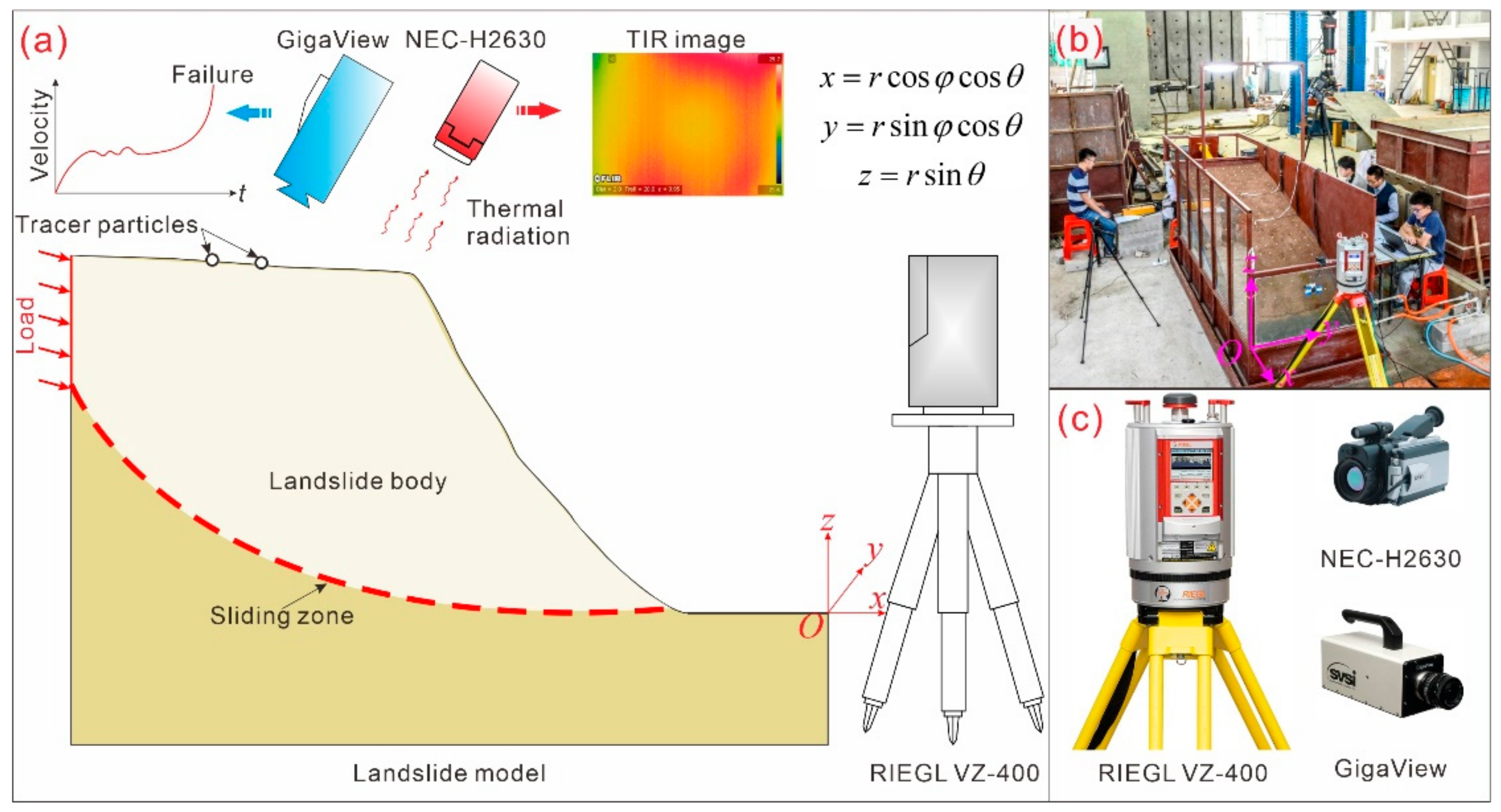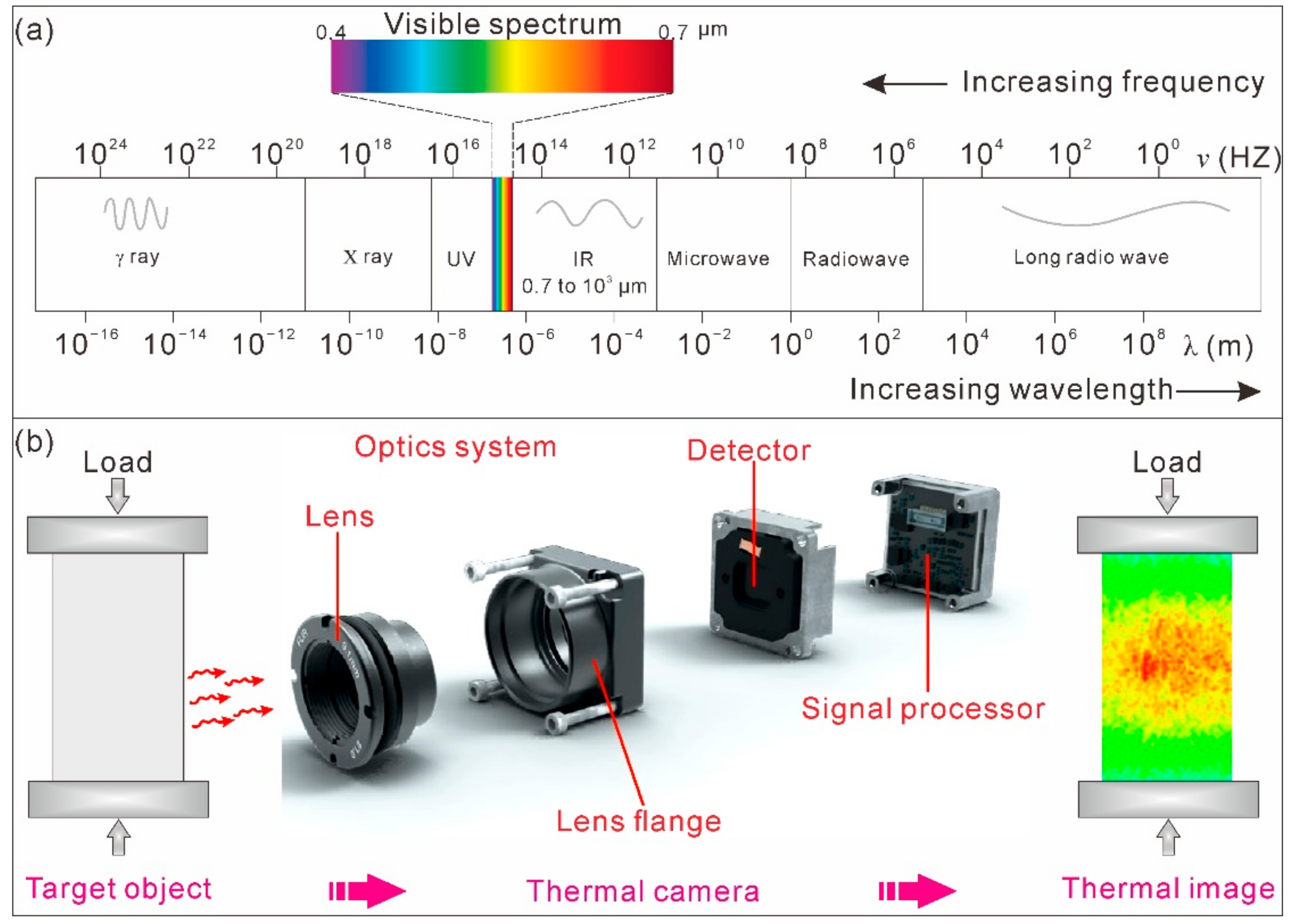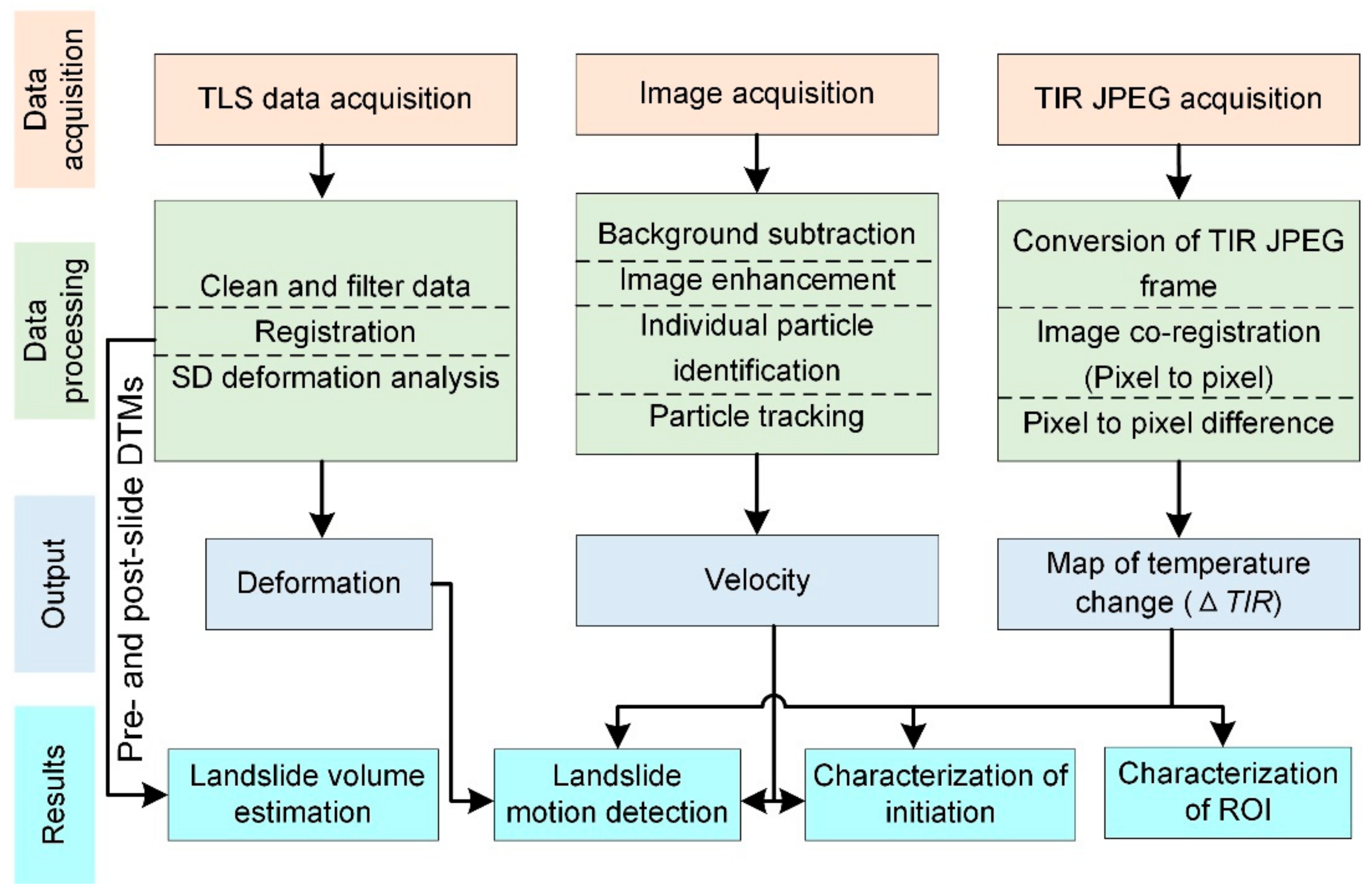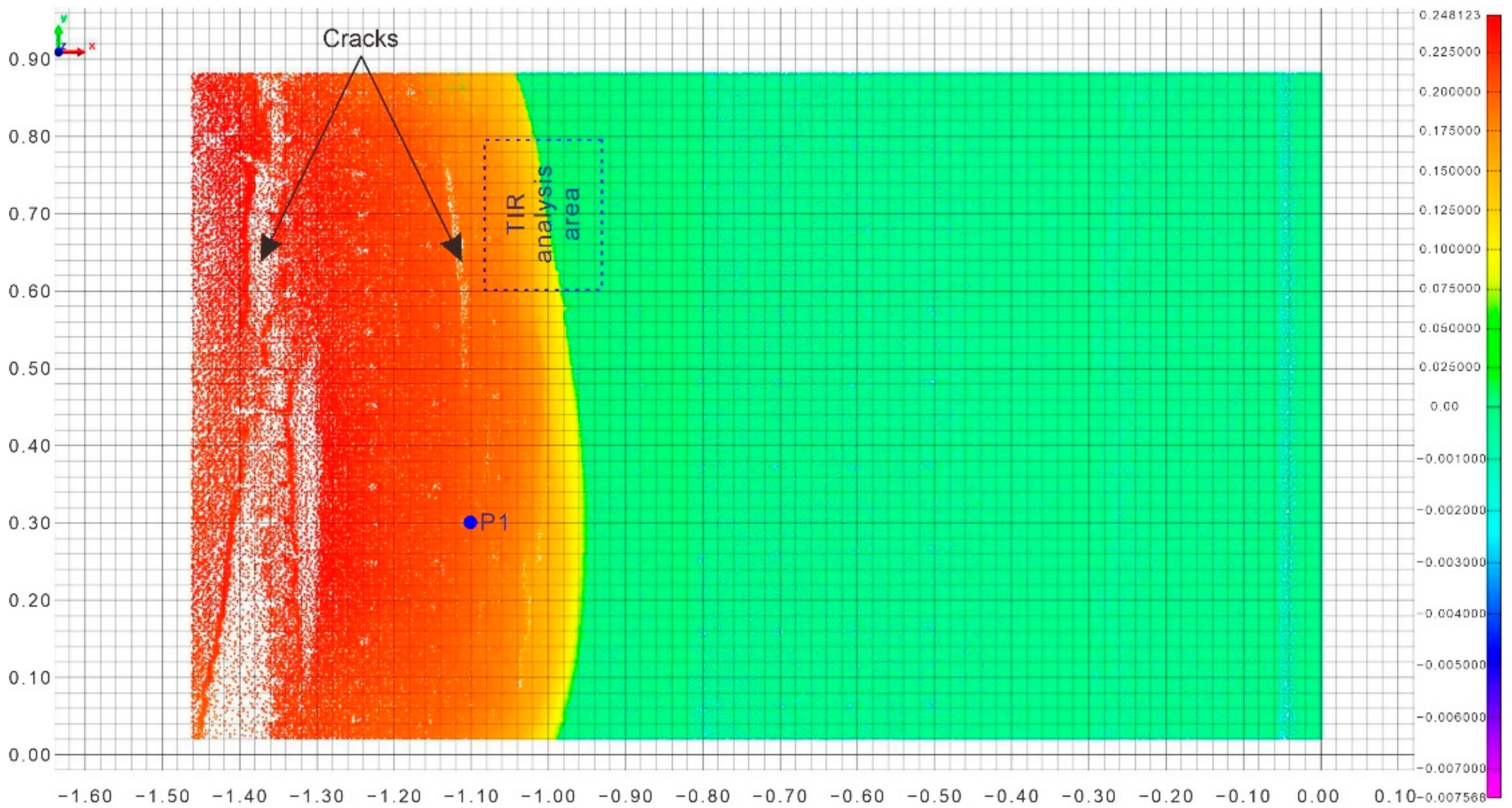Thermal Infrared Imagery Integrated with Terrestrial Laser Scanning and Particle Tracking Velocimetry for Characterization of Landslide Model Failure
Abstract
1. Introduction
2. Materials and Methods
2.1. Descriptions of the Landslide Model Test
2.2. Integrated Monitoring System
2.2.1. TIR Imagery
2.2.2. TLS
2.2.3. PTV
2.3. Data Preprocessing
3. Results
3.1. Characteristics of Landslide Motion and Initiation
3.1.1. Landslide Volume Estimation
3.1.2. Landslide Initiation and Motion
3.2. Characteristics of ROI
4. Discussion
5. Conclusions
Author Contributions
Funding
Acknowledgments
Conflicts of Interest
References
- Froude, M.J.; Petley, D. Global fatal landslide occurrence from 2004 to 2016. Nat. Hazards Earth Syst. Sci. 2018, 18, 2161–2181. [Google Scholar] [CrossRef]
- Prokop, A.; Panholzer, H. Assessing the capability of terrestrial laser scanning for monitoring slow moving landslides. Nat. Hazards Earth Syst. Sci. 2009, 9, 1921–1928. [Google Scholar] [CrossRef]
- Barbarella, M.; Fiani, M.; Lugli, A. Landslide monitoring using multitemporal terrestrial laser scanning for ground displacement analysis. Geomat. Nat. Hazards Risk 2015, 6, 398–418. [Google Scholar] [CrossRef]
- Tomas, R.; Li, Z.; Lopez-Sanchez, J.; Liu, P.; Singleton, A. Using wavelet tools to analyse seasonal variations from InSAR time-series data: A case study of the Huangtupo landslide. Landslides 2016, 13, 437–450. [Google Scholar] [CrossRef]
- Bayer, B.; Simoni, A.; Schmidt, D.; Bertello, L. Using advanced InSAR techniques to monitor landslide deformations induced by tunneling in the Northern Apennines, Italy. Eng. Geol. 2017, 226, 20–32. [Google Scholar] [CrossRef]
- Peternel, T.; Kumelj, Š.; Oštir, K.; Komac, M. Monitoring the Potoška planina landslide (NW Slovenia) using UAV photogrammetry and tachymetric measurements. Landslides 2017, 14, 395–406. [Google Scholar] [CrossRef]
- Lindner, G.; Schraml, K.; Mansberger, R.; Hübl, J. UAV monitoring and documentation of a large landslide. Appl. Geomat. 2016, 8, 1–11. [Google Scholar] [CrossRef]
- Turner, D.; Lucieer, A.; De Jong, M.S. Time Series Analysis of Landslide Dynamics Using an Unmanned Aerial Vehicle (UAV). Remote Sens. 2015, 7, 1736–1757. [Google Scholar] [CrossRef]
- Frodella, W.; Gigli, G.; Morelli, S.; Lombardi, L.; Casagli, N. Landslide Mapping and Characterization through Infrared Thermography (IRT): Suggestions for a Methodological Approach from Some Case Studies. Remote Sens. 2017, 9, 1281. [Google Scholar] [CrossRef]
- Morello, R. Potentialities and limitations of thermography to assess landslide risk. Measurement 2018, 116, 658–668. [Google Scholar] [CrossRef]
- Sun, Y.J.; Zhang, D.; Shi, B.; Tong, H.J.; Wei, G.Q.; Wang, X. Distributed acquisition, characterization and process analysis of multi-field information in slopes. Eng. Geol. 2014, 182, 49–62. [Google Scholar] [CrossRef]
- Teena, M.; Manickavasagan, A. Thermal Infrared Imaging. In Imaging with Electromagnetic Spectrum: Applications in Food and Agriculture; Manickavasagan, A., Jayasuriya, H., Eds.; Springer: Berlin/Heidelberg, Germany, 2014; pp. 147–173. [Google Scholar] [CrossRef]
- Kuenzer, C.; Zhang, J.; Li, J.; Voigt, S.; Mehl, H.; Wagner, W. Detecting unknown coal fires: Synergy of automated coal fire risk area delineation and improved thermal anomaly extraction. Int. J. Remote Sens. 2007, 28, 4561–4585. [Google Scholar] [CrossRef]
- Sobrino, J.A.; Frate, F.D.; Drusch, M.; Jiménez-Muñoz, J.C.; Manunta, P.; Regan, A. Review of Thermal Infrared Applications and Requirements for Future High-Resolution Sensors. IEEE Trans. Geosci. Remote 2016, 54, 2963–2972. [Google Scholar] [CrossRef]
- Shikada, M.; Kusaka, T.; Kawata, Y.; Miyakita, K. Extraction of characteristic properties in landslide areas using thematic map data and surface temperature. In Proceedings of the International Geoscience and Remote Sensing Symposium (IGARSS), Better Understanding of Earth Environment, Tokyo, Japan, 18–21 August 1993; pp. 103–105. [Google Scholar]
- Kusaka, T.; Shikada, M.-A.; Kawata, Y. Inference of landslide areas using spatial features and surface temperature of watersheds. In Proceedings of the SPIE International Symposium on Optical Engineering and Photonics Aerospace and Remote Sensing, Orlando, FL, USA, 31 August 1993; pp. 241–246. [Google Scholar]
- Zhang, Y.Q.; Tang, H.M.; Li, C.D.; Lu, G.Y.; Cai, Y.; Zhang, J.R.; Tan, F.L. Design and testing of a flexible inclinometer probe for model tests of landslide deep displacement measurement. Sensors 2018, 18, 224. [Google Scholar] [CrossRef] [PubMed]
- Miao, F.; Wu, Y.; Li, L.; Tang, H.; Li, Y. Centrifuge model test on the retrogressive landslide subjected to reservoir water level fluctuation. Eng. Geol. 2018, 245, 169–179. [Google Scholar] [CrossRef]
- Wu, L.Z.; Zhang, L.M.; Zhou, Y.; Xu, Q.; Yu, B.; Liu, G.G.; Bai, L.Y. Theoretical analysis and model test for rainfall-induced shallow landslides in the red-bed area of Sichuan. Bull. Eng. Geol. Environ. 2018, 77, 1343–1353. [Google Scholar] [CrossRef]
- Li, C.; Yao, D.; Wang, Z.; Liu, C.; Wuliji, N.; Yang, L.; Li, L.; Amini, F. Model test on rainfall-induced loess–mudstone interfacial landslides in Qingshuihe, China. Environ. Earth Sci. 2016, 75, 835. [Google Scholar] [CrossRef]
- Fan, L.; Zhang, G.; Li, B.; Tang, H. Deformation and failure of the Xiaochatou Landslide under rapid drawdown of the reservoir water level based on centrifuge tests. Bull. Eng. Geol. Environ. 2017, 76, 891–900. [Google Scholar] [CrossRef]
- Wang, K.; Zhang, S.; Chen, J.; Teng, P.; Wei, F.; Chen, Q. A Laboratory Experimental Study: An FBG-PVC Tube Integrated Device for Monitoring the Slip Surface of Landslides. Sensors 2017, 17, 2486. [Google Scholar] [CrossRef]
- Chen, Y.; Irfan, M.; Uchimura, T.; Zhang, K. Feasibility of Using Elastic Wave Velocity Monitoring for Early Warning of Rainfall-Induced Slope Failure. Sensors 2018, 18, 997. [Google Scholar] [CrossRef]
- Li, M.; Cheng, W.; Chen, J.; Xie, R.; Li, X. A High Performance Piezoelectric Sensor for Dynamic Force Monitoring of Landslide. Sensors 2017, 17, 394. [Google Scholar] [CrossRef] [PubMed]
- Ma, J.W.; Tang, H.M.; Hu, X.L.; Bobet, A.; Zhang, M.; Zhu, T.W.; Song, Y.J.; Ez Eldin, M.A.M. Identification of causal factors for the Majiagou landslide using modern data mining methods. Landslides 2017, 14, 311–322. [Google Scholar] [CrossRef]
- Zhang, M.; Nie, L.; Xu, Y.; Dai, S. A thrust load-caused landslide triggered by excavation of the slope toe: A case study of the Chaancun Landslide in Dalian City, China. Arab. J. Geosci. 2015, 8, 6555–6565. [Google Scholar] [CrossRef]
- Mujtaba, B.; de Lima, J.L.M.P. Laboratory testing of a new thermal tracer for infrared-based PTV technique for shallow overland flows. Catena 2018, 169, 69–79. [Google Scholar] [CrossRef]
- Jiang, C.; Dong, Z.; Wang, X. An improved particle tracking velocimetry (PTV) technique to evaluate the velocity field of saltating particles. J. Arid Land 2017, 9, 727–742. [Google Scholar] [CrossRef]
- Liu, K.; Liu, D. Particle tracking velocimetry and flame front detection techniques on commercial aircraft debris striking events. J. Vis. 2019, 22, 783–794. [Google Scholar] [CrossRef]
- Tauro, F.; Piscopia, R.; Grimaldi, S. PTV-Stream: A simplified particle tracking velocimetry framework for stream surface flow monitoring. Catena 2019, 172, 378–386. [Google Scholar] [CrossRef]
- Patalano, A.; García, C.M.; Rodríguez, A. Rectification of Image Velocity Results (RIVeR): A simple and user-friendly toolbox for large scale water surface Particle Image Velocimetry (PIV) and Particle Tracking Velocimetry (PTV). Comput. Geosci. 2017, 109, 323–330. [Google Scholar] [CrossRef]
- Bautista-Capetillo, C.; Robles, O.; Salinas, H.; Playán, E. A particle tracking velocimetry technique for drop characterization in agricultural sprinklers. Irrig. Sci. 2014, 32, 437–447. [Google Scholar] [CrossRef]
- Umeyama, M. Coupled PIV and PTV Measurements of Particle Velocities and Trajectories for Surface Waves Following a Steady Current. J. Waterw. Port Coast. Ocean Eng. 2011, 137, 85–94. [Google Scholar] [CrossRef]
- Liu, C.; Yuen, J.; Torralba, A. SIFT Flow: Dense Correspondence across Scenes and Its Applications. IEEE Trans. Pattern Anal. Mach. Intell. 2011, 33, 978–994. [Google Scholar] [CrossRef] [PubMed]







| Term | Value | Term | Value |
|---|---|---|---|
| Length of the landslide body (m) | 1.76 | Cohesion of the landslide body (kPa) | 3.9 |
| Width of the landslide body (m) | 0.9 | Cohesion of the sliding zone (kPa) | 5.6 |
| Average thickness of the landslide body | 0.25 | Friction angle of the landslide body (°) | 26.8 |
| Average inclination of the surface (°) | 22 | Friction angle of the sliding zone (°) | 18.1 |
| Average inclination of the sliding zone (°) | 19 | Elastic modulus of the landslide body (MPa) | 2.5 |
| Volume of the landslide body (m3) | 0.405 | Elastic modulus of the sliding zone (MPa) | 2.2 |
| Density of the landslide body (kg/m3) | 22.1 | Duration (h) | 8.52 |
| Density of the sliding zone (kg/m3) | 17.1 | Peak load (N) | 1873.32 |
| Monitoring Unit | Specifications |
|---|---|
| NEC-H2630 | Measuring range (°C): −40 to 500 |
| Resolution (°C): 0.04 °C or better (at 30 °C, ∑16 *) | |
| Accuracy: ±2% of reading | |
| Spectral range (μm): 8 to 13 | |
| Focusing range: 30 cm to infinity | |
| Thermal image pixels: 640 (H) × 480 (V) | |
| RIEGL VZ-400 | Maximum pulse repetition rate (PRR) (kHz): 300 (high-speed model) |
| Effective measurement rate (meas./sec): 122,000 (high-speed model) | |
| Minimum range (m): 1.5 | |
| Maximum range (m): 600 (long-range model)/350 (high-speed model) | |
| Accuracy | Precision (mm): 5/3 | |
| Laser wavelength (nm): 1550 | |
| Laser beam divergence (mrad): 0.3 | |
| GigaView | Resolution: 1280 × 1024 |
| Frame-rates (fps): 50 to 17,000 | |
| Shutter: 1/50–1/100,000 | |
| Sensor: 10-bit mono or 24-bit color |
| Time (h) | (°C) | Room Temperature (°C) | Time (h) | (°C) | Room Temperature (°C) |
|---|---|---|---|---|---|
| 0.0 | 0.000 | 23.3 | 5.3 | 0.578 | 23.3 |
| 1.2 | 0.002 | 23.3 | 5.4 | 0.638 | 23.3 |
| 1.5 | 0.002 | 23.3 | 5.7 | 0.653 | 24 |
| 1.8 | 0.032 | 23.3 | 6.0 | 0.649 | 24 |
| 2.0 | 0.025 | 23.3 | 5.3 | 0.578 | 24 |
| 2.3 | 0.073 | 23.3 | 6.3 | 0.755 | 24 |
| 2.8 | 0.131 | 23.3 | 6.5 | 0.875 | 24 |
| 3.0 | 0.145 | 23.3 | 6.8 | 1.119 | 23.5 |
| 3.3 | 0.229 | 23.3 | 7.0 | 1.197 | 23.5 |
| 3.5 | 0.291 | 23.3 | 7.3 | 1.179 | 23.5 |
| 3.8 | 0.319 | 23.3 | 7.5 | 1.145 | 23.5 |
| 4.0 | 0.331 | 23.3 | 7.8 | 1.135 | 23.5 |
| 4.3 | 0.435 | 23.3 | 8.1 | 1.106 | 23.5 |
| 4.5 | 0.466 | 23.3 | 8.3 | 1.045 | 23.5 |
| 4.8 | 0.480 | 23.3 | 8.7 | 1.098 | 23.5 |
© 2019 by the authors. Licensee MDPI, Basel, Switzerland. This article is an open access article distributed under the terms and conditions of the Creative Commons Attribution (CC BY) license (http://creativecommons.org/licenses/by/4.0/).
Share and Cite
Ma, J.; Niu, X.; Liu, X.; Wang, Y.; Wen, T.; Zhang, J. Thermal Infrared Imagery Integrated with Terrestrial Laser Scanning and Particle Tracking Velocimetry for Characterization of Landslide Model Failure. Sensors 2020, 20, 219. https://doi.org/10.3390/s20010219
Ma J, Niu X, Liu X, Wang Y, Wen T, Zhang J. Thermal Infrared Imagery Integrated with Terrestrial Laser Scanning and Particle Tracking Velocimetry for Characterization of Landslide Model Failure. Sensors. 2020; 20(1):219. https://doi.org/10.3390/s20010219
Chicago/Turabian StyleMa, Junwei, Xiaoxu Niu, Xiao Liu, Yankun Wang, Tao Wen, and Junrong Zhang. 2020. "Thermal Infrared Imagery Integrated with Terrestrial Laser Scanning and Particle Tracking Velocimetry for Characterization of Landslide Model Failure" Sensors 20, no. 1: 219. https://doi.org/10.3390/s20010219
APA StyleMa, J., Niu, X., Liu, X., Wang, Y., Wen, T., & Zhang, J. (2020). Thermal Infrared Imagery Integrated with Terrestrial Laser Scanning and Particle Tracking Velocimetry for Characterization of Landslide Model Failure. Sensors, 20(1), 219. https://doi.org/10.3390/s20010219









